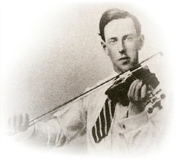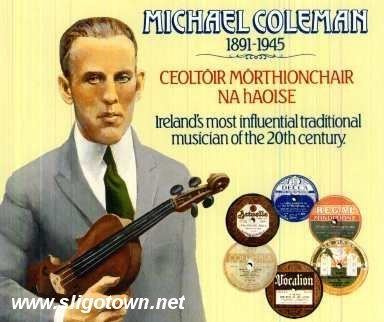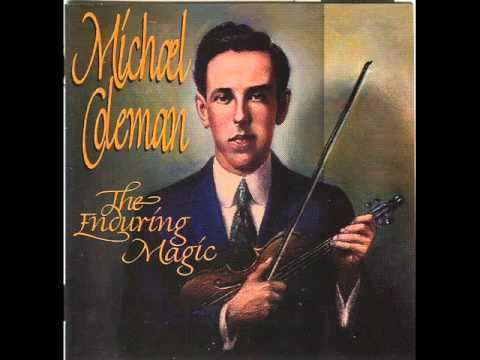Genres Irish folk Name Michael Coleman Years active 1909–1945 | Instruments Fiddle Occupation(s) Musician Role Musician | |
 | ||
Died January 4, 1945, New York City, New York, United States Albums Michael Coleman 1891 to 1945, Irish Jigs and Reels Similar People Paddy Killoran, Brian Conway, Packie Dolan, Joe Burke, Kevin Burke | ||
The making of whispers secrecy michael coleman
Michael Coleman (January 31, 1891 – January 4, 1945) was an Irish fiddler from County Sligo, and a major exponent of the Sligo fiddle style.
Contents
- The making of whispers secrecy michael coleman
- Michael coleman at the knuckle down saloon 2 14 2013
- Early years
- Immigration to the United States
- Legacy
- Discography
- References

Michael coleman at the knuckle down saloon 2 14 2013
Early years

Michael Coleman was born in Knockgrania, in the rural Killavil district, near Ballymote, County Sligo, Ireland. His father, James Coleman, was from Banada in County Roscommon, and a respected flute player. Michael was the seventh child of James and Beatrice, and the surviving half of a pair of twins.
As a child he learned step dancing and fiddle playing, and performed at local houses. His elder brother Jim had a high reputation but was never recorded. In his formative years Michael was influenced by Uilleann pipers (a type of bagpipe), including Johnny Gorman.
He left school in 1908, at the age of 17. He competed at the Sligo Feis Ceoil in 1909 and again in 1910, and was placed joint third on both occasions. In 1914 he moved to Manchester, England to live with his older brother Pat, but returned home after several months.
Immigration to the United States
In October 1914, at the age of twenty-three, Coleman sailed to America with his friend John Hunt. Initially he stayed with his aunt in Lowell, Massachusetts and joined the Keith Theatres vaudeville circuit. In 1917, he settled in New York City, and married Marie Fanning, originally from County Monaghan, Ireland. They had one child, Mary.
Between 1921 and 1936 he recorded roughly eighty commercial 78-rpm records for many record labels, including: Shannon, Vocalion Records, Columbia Records, Okeh Records, New Republic, Pathe, O'Beirne de Witt, Victor Records, Brunswick Records, and Decca Records. Some of these were re-issued under the Intrepid, Coral Records, and Ace of Hearts labels.
Coleman was usually accompanied by one of the following pianists: Kathleen Brennan, Arthur P. Kenna, John Muller, Eileen O’Shea, Edward Lee, and Ed Geoghegan. However, on three 1934 78 discs (six sides) for the Decca label, Coleman was accompanied by tenor guitar player Michael "Whitey" Andrews. Notable Irish flute players Michael Walsh and Tom Morrison also accompanied Coleman on a few of his 1920s recordings. In total, Coleman recorded roughly ninety records. At least ten of Coleman's final recordings were either radio broadcasts, or solo acetates recorded in the years 1937-1944. Few of these historic recordings have been released to date.
Coleman was the most famous exponent of what is today known as the Sligo fiddle style, which is fast and flamboyant, and heavily ornamented with fingered "rolls" and bowed triplets. James Morrison, Paddy Killoran and Paddy Sweeney were other famed Sligo fiddlers who also recorded in New York in the 1920s and '30s. Other notable mentions are Hugh Gillespie and Andy McGann who were both students of Coleman. While these musicians shared a basic approach and much common repertoire, there were noticeable differences in their playing. Coleman in particular employed extensive melodic variations, and his settings of tunes such as "The Boys of the Lough," "Bonny Kate" and "Lord Gordon's" have become part of the standard Irish fiddle repertoire. Some of Coleman's records were reissued on British labels and others reached Ireland as American imports, heavily influencing a new generation of fiddlers in Sligo and elswehere. Coleman died in New York City, and is buried in St. Raymond's Cemetery in the Bronx.
Legacy
Coleman's influence on traditional fiddle playing is substantial. Every generation since has been influenced by his recordings either directly or indirectly. Most notably, he has influenced fiddle players such as Lad O'Beirne, Martin Wynne, Ben Lennon, Martin Byrnes and many others.
In 1974, a monument was erected by the Coleman Traditional Society. It is close to his birthplace, on the Tubbercurry to Gurteen road. Nearby is the Coleman Heritage Centre, a music archive and a replica of the house where he lived. The monument bears this inscription:
"Michael Coleman. Master of the fiddle. Saviour of Irish traditional music. Born near this spot in 1891. Died in exile 1945."In March 2015, the U.S. Library of Congress chose its annual list of sound recordings for inclusion in its National Recording Registry. Among those chosen were Coleman's 1922 Vocalion Records release of his rendition of "The Boys of the Lough" and "The Humours of Ennistymon".
